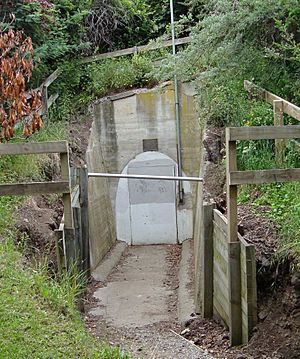Cracroft Caverns facts for kids
Quick facts for kids Cracroft Caverns |
|
|---|---|
| Cashmere | |

Entrance to Cracroft Caverns
|
|
| Coordinates | 43°34′28″S 172°37′23″E / 43.57444°S 172.62306°E |
| Site information | |
| Controlled by | Christchurch City Council |
| Open to the public |
No |
| Site history | |
| Built | 1942 |
The Cracroft Caverns, also called the Cashmere Caverns, are a group of big underground rooms. You can find them hidden inside a hill in the Cashmere area of Christchurch, New Zealand.
These secret tunnels were built during World War Two. They were meant to be a safe place for military leaders if New Zealand was attacked.
Contents
Secret Tunnels for War
During World War Two, there was a fear that Japan might attack. Because of this, the military decided to build a secret headquarters underground. They took over a property called the Cracroft Wilson estate in 1942. This estate was first started by Sir John Cracroft Wilson in 1854.
Work on the tunnels began right away. They even built small railways inside to help move dirt out. The biggest room was huge! It was 7 meters high, 10 meters wide, and 30 meters long. The tunnels were lined with strong concrete to make them safe.
Officers who lived in the estate house could go down stairs into the tunnels. Other people would use special access tunnels to get inside.
Why Building Stopped
Building the caverns stopped suddenly in 1944. This happened because the danger of an invasion became much smaller. Even though the bunkers were almost finished, work stopped.
Just before the military left the estate, a fire broke out. The Cracroft Wilson House burned down completely.
Rediscovering the Caverns
After the war, the entrances to the underground tunnels were sealed up. Most people forgot that the caverns even existed.
Then, in 1987, a TV reporter named Jeff Field heard about them. He was talking to a gardener at Cashmere Hospital who mentioned the caverns by chance.
Jeff Field looked through old records at the Ministry of Defence. He found newspaper articles from January 1945 that talked about the caverns. Another reporter, Bill Cockram, took over the investigation. He contacted the owner of Cashmere House, which had been rebuilt after the fire.
With the owner's permission, they started digging. For the first time since World War Two, people went back inside the Cracroft Caverns.
What Happens There Now
Today, the caverns are used for special science experiments. Scientists from the University of Canterbury's physics department use them for "ring laser" experiments.
The caves are perfect for this because the temperature inside stays very steady. This helps the experiments work really well.
There's also a small public park nearby, behind the Princess Margaret Hospital.
Sometimes in the past, parts of the caverns were opened for people to visit. However, they were damaged by the 2010 Canterbury earthquake and 2011 Christchurch earthquakes. Because of this damage, you cannot visit the caverns right now.
Images for kids



